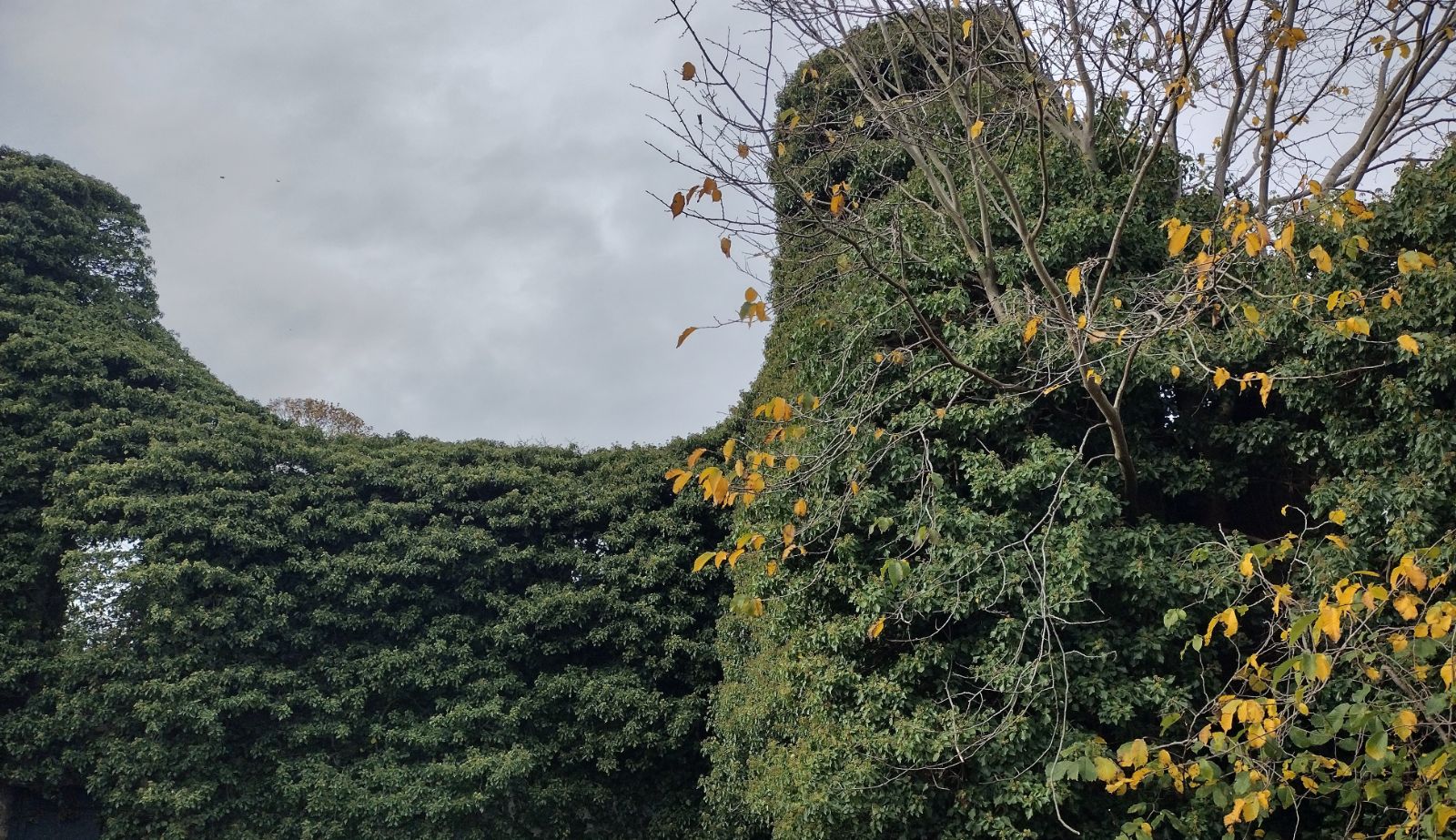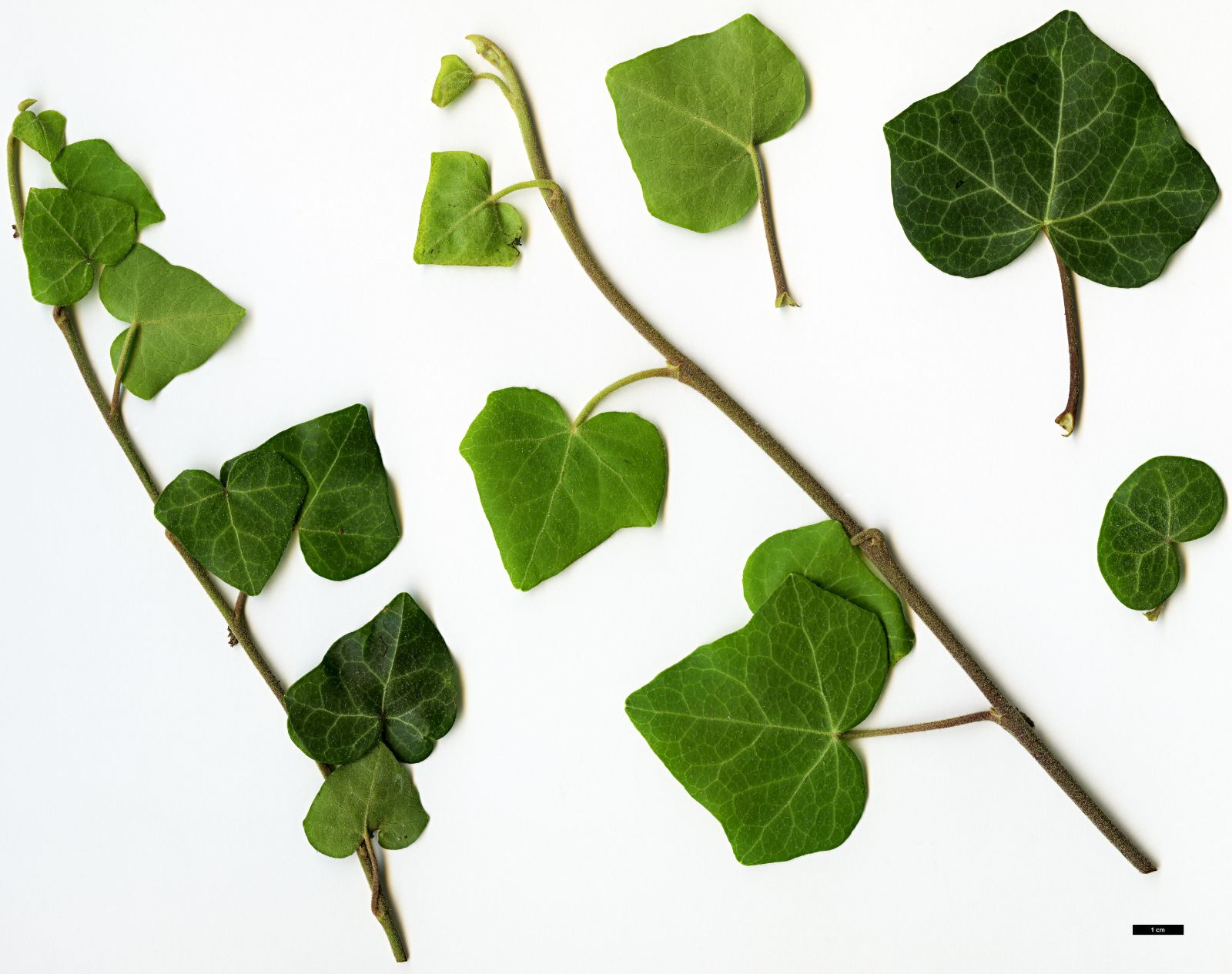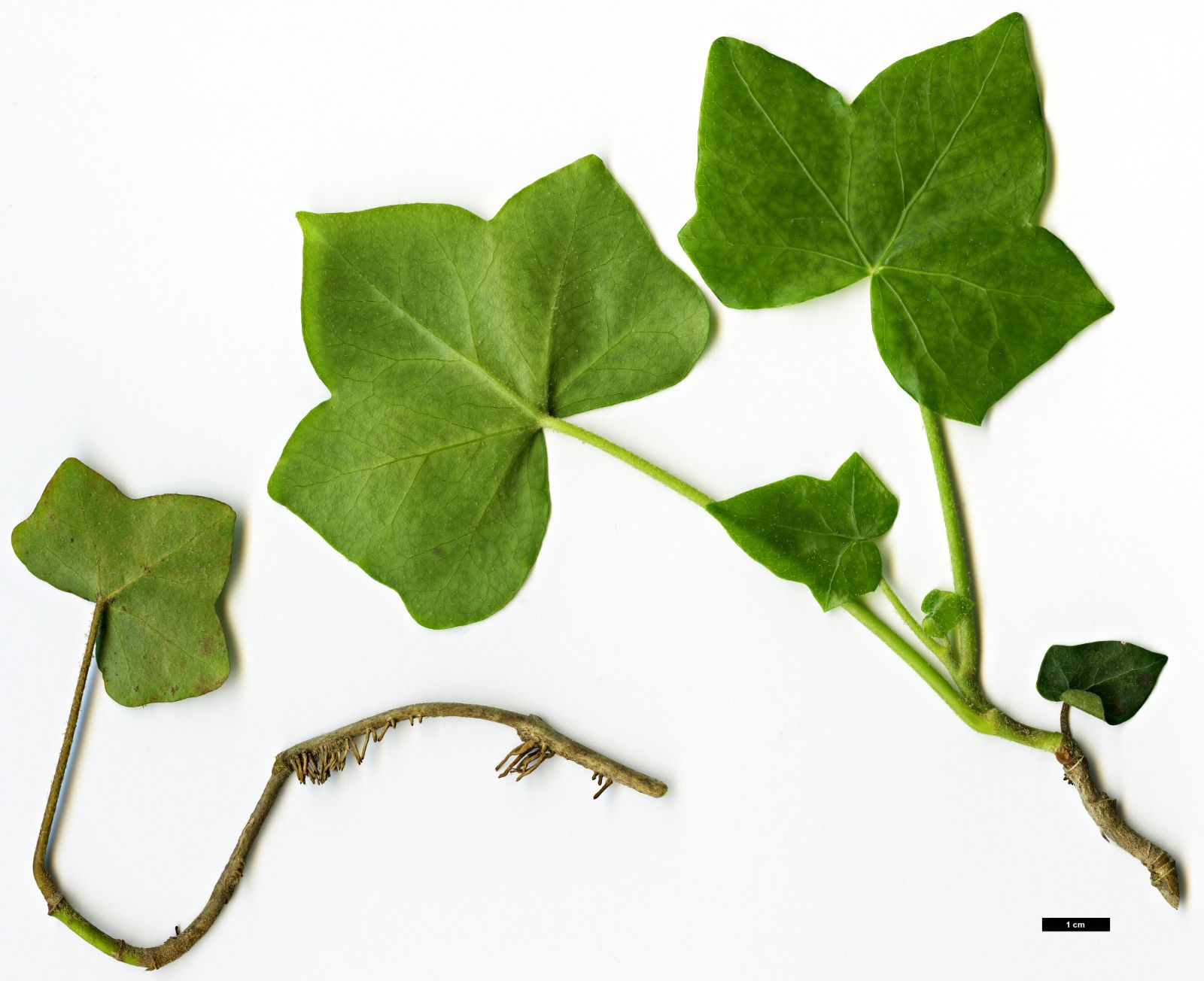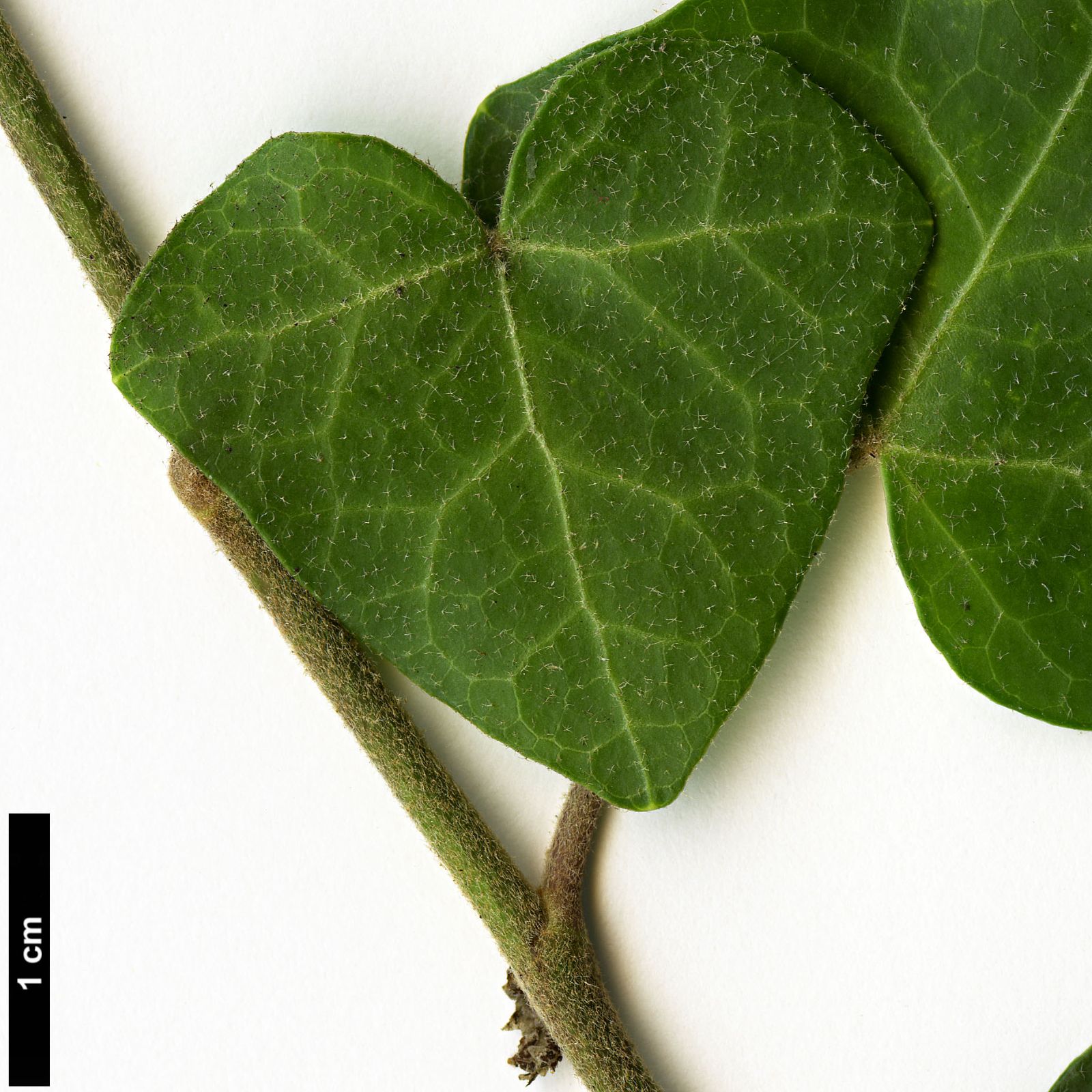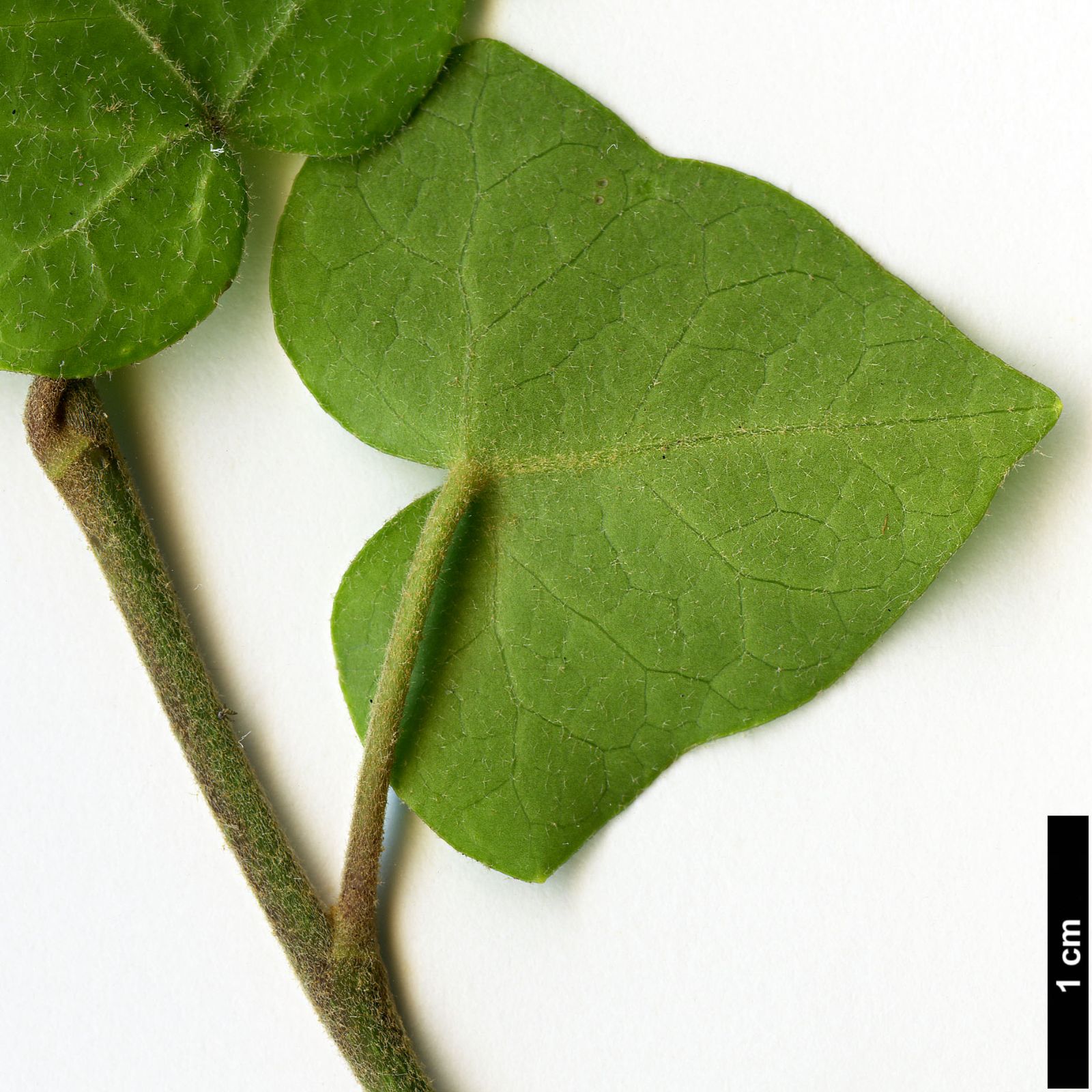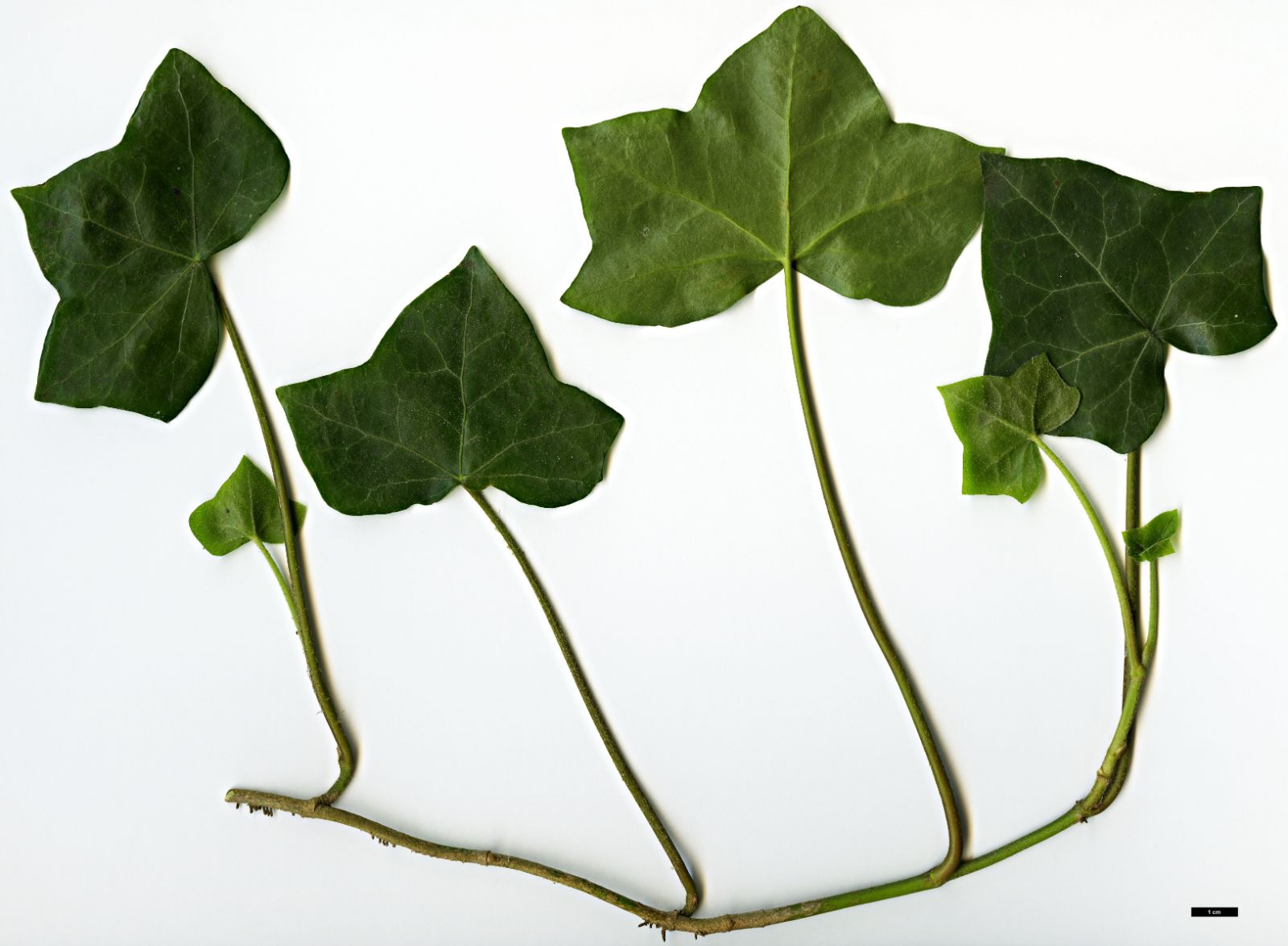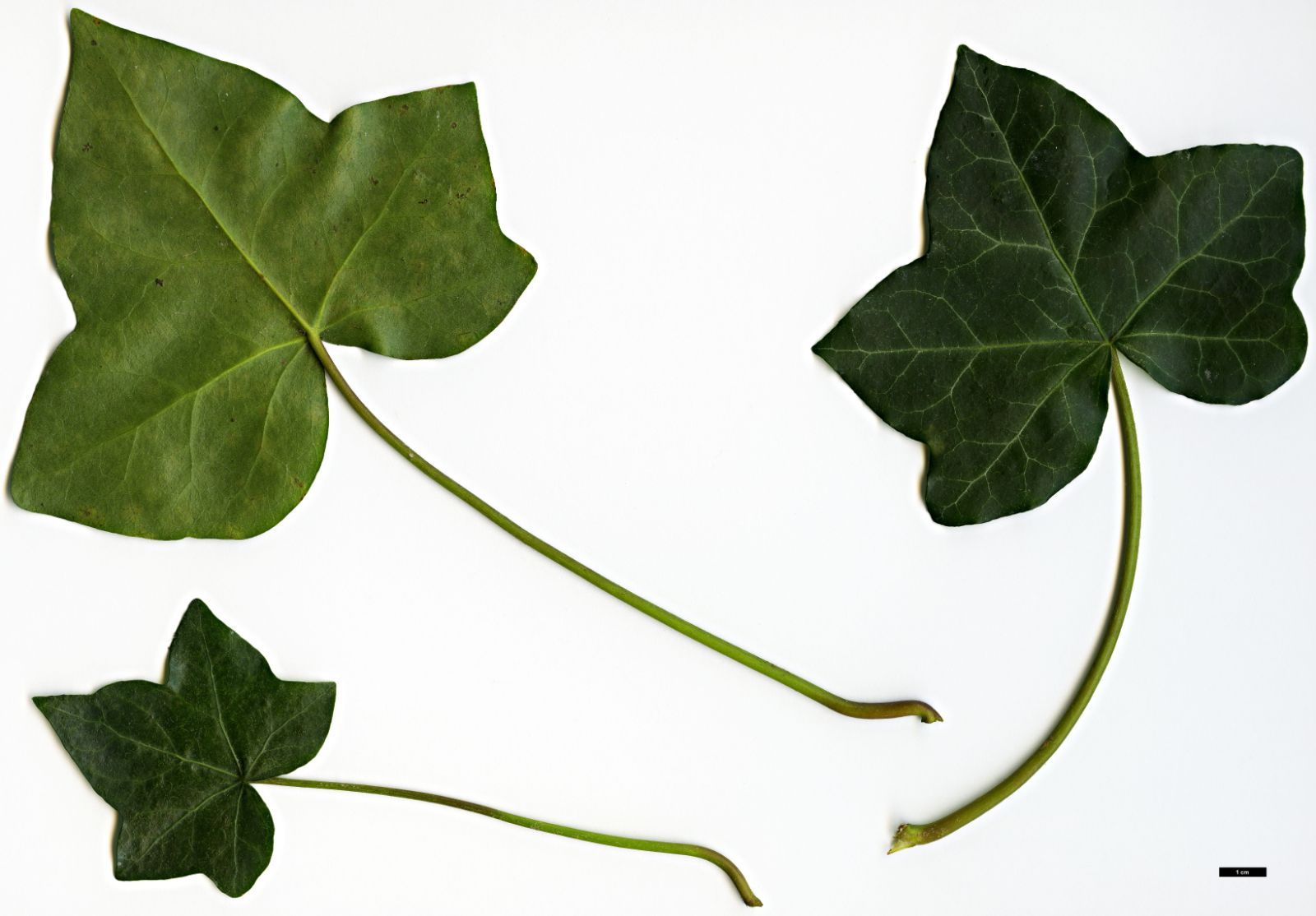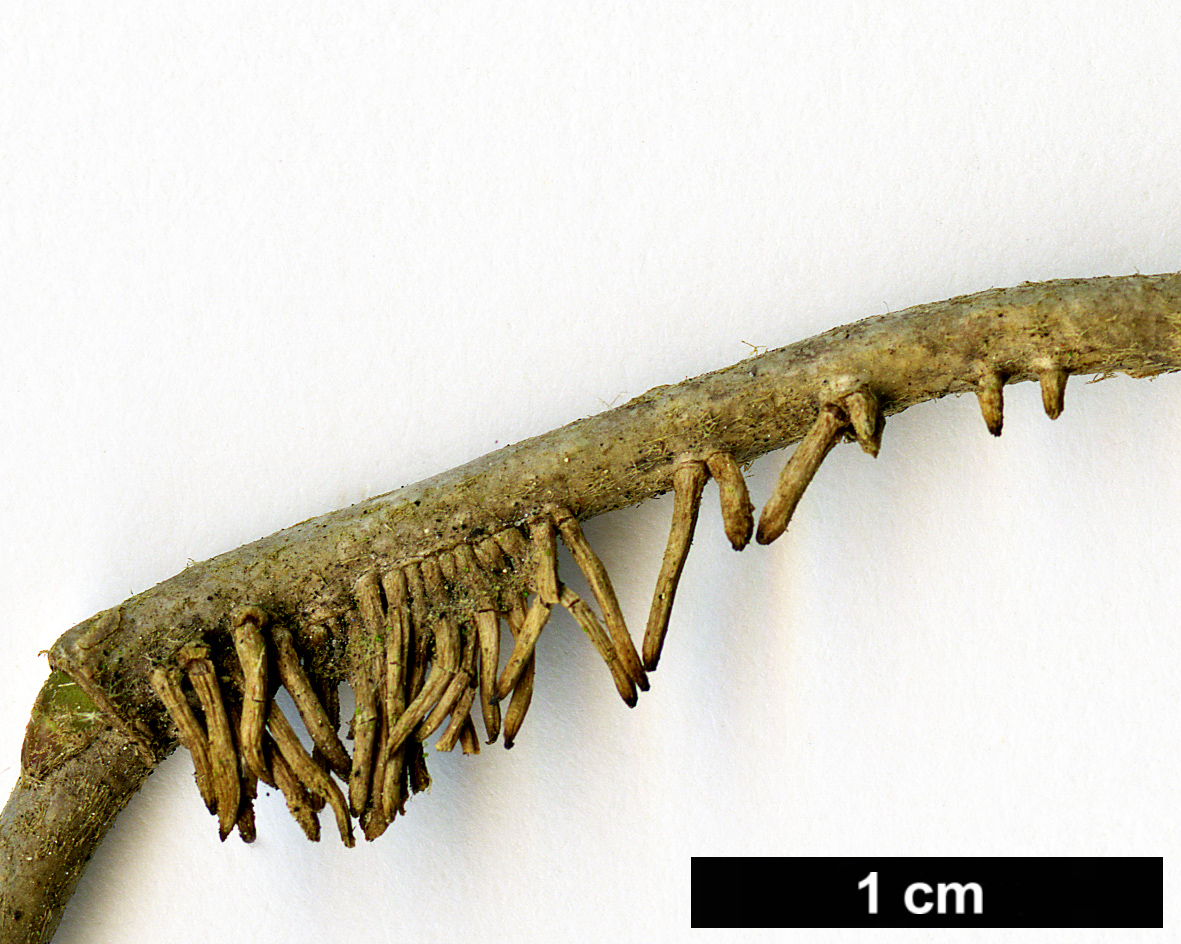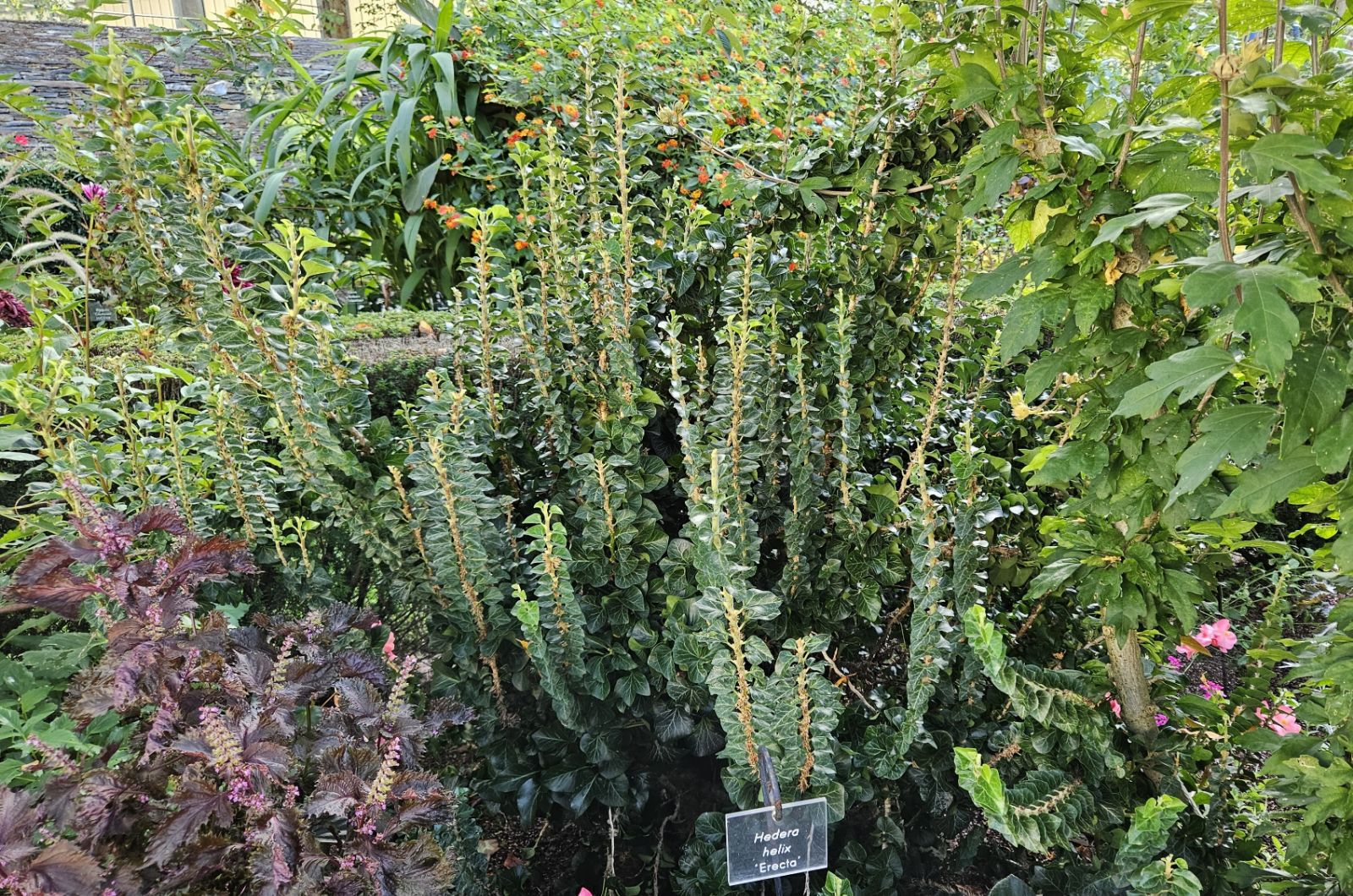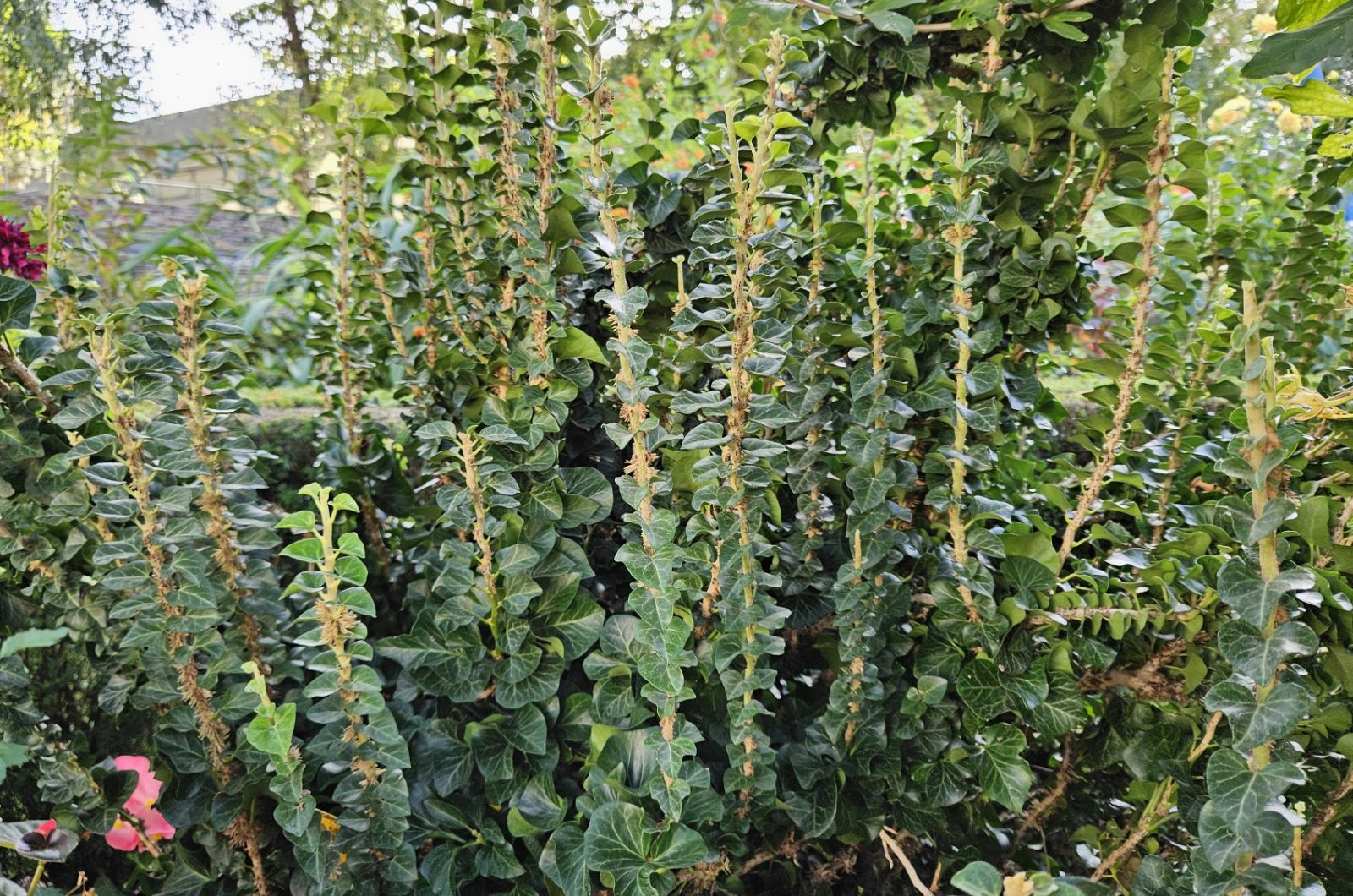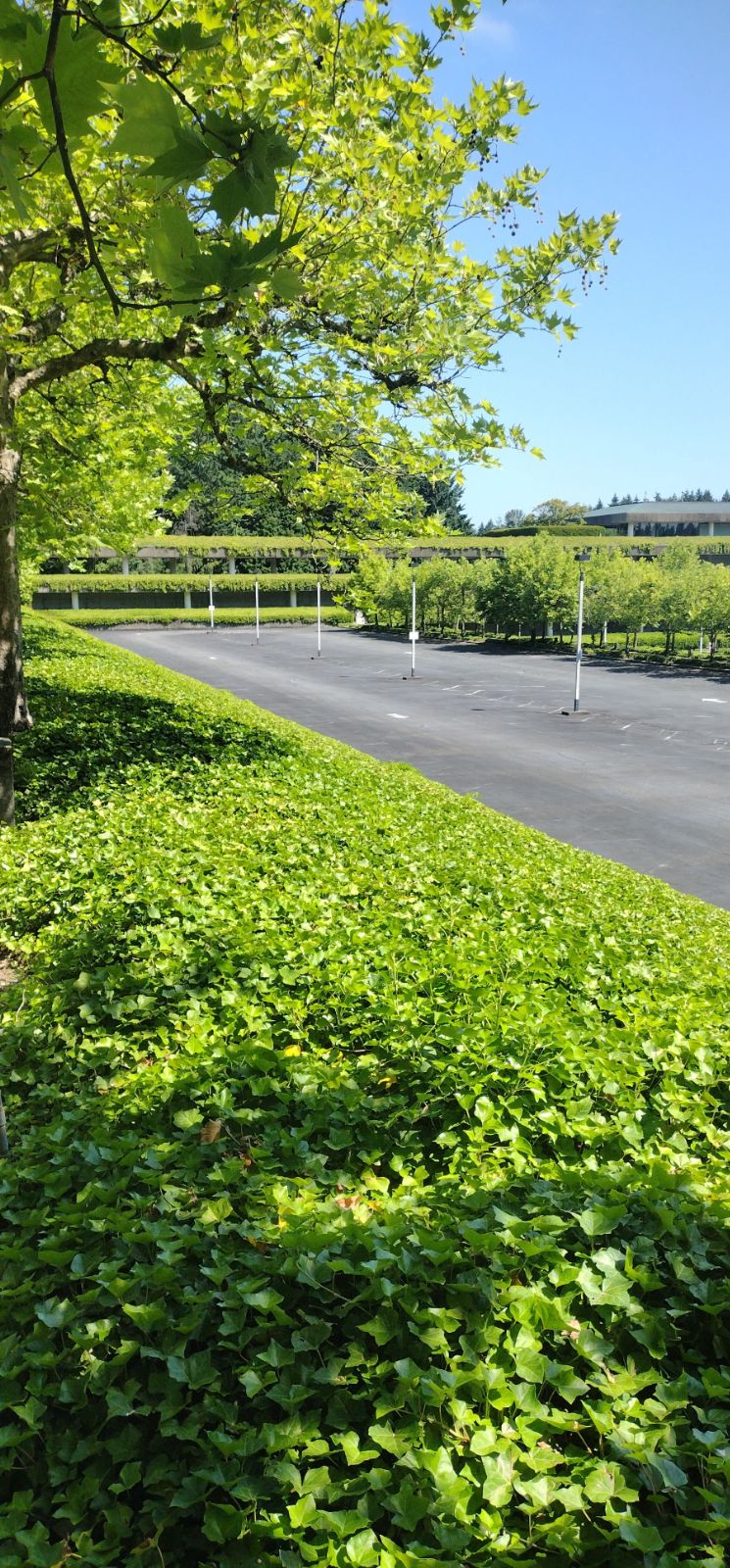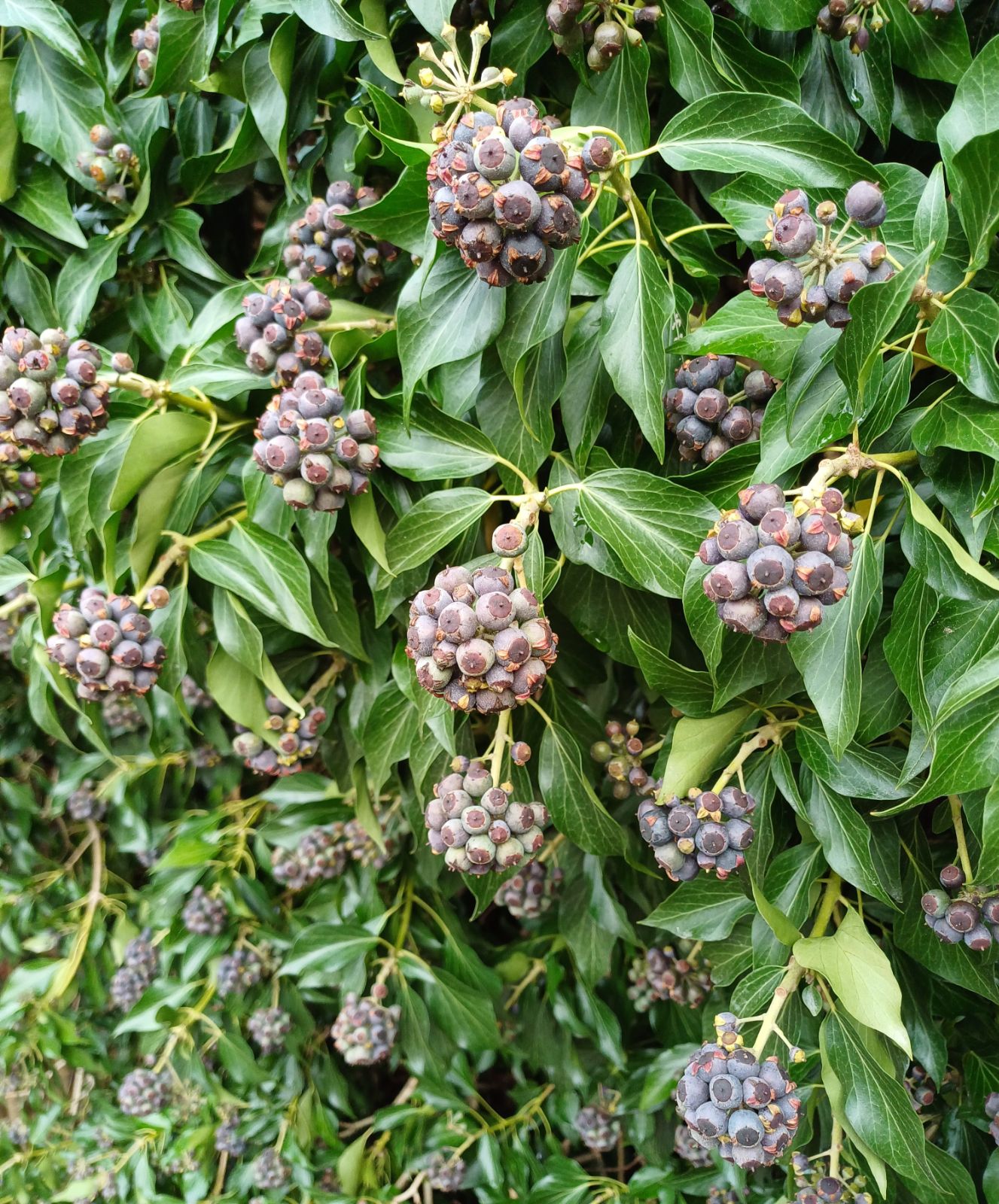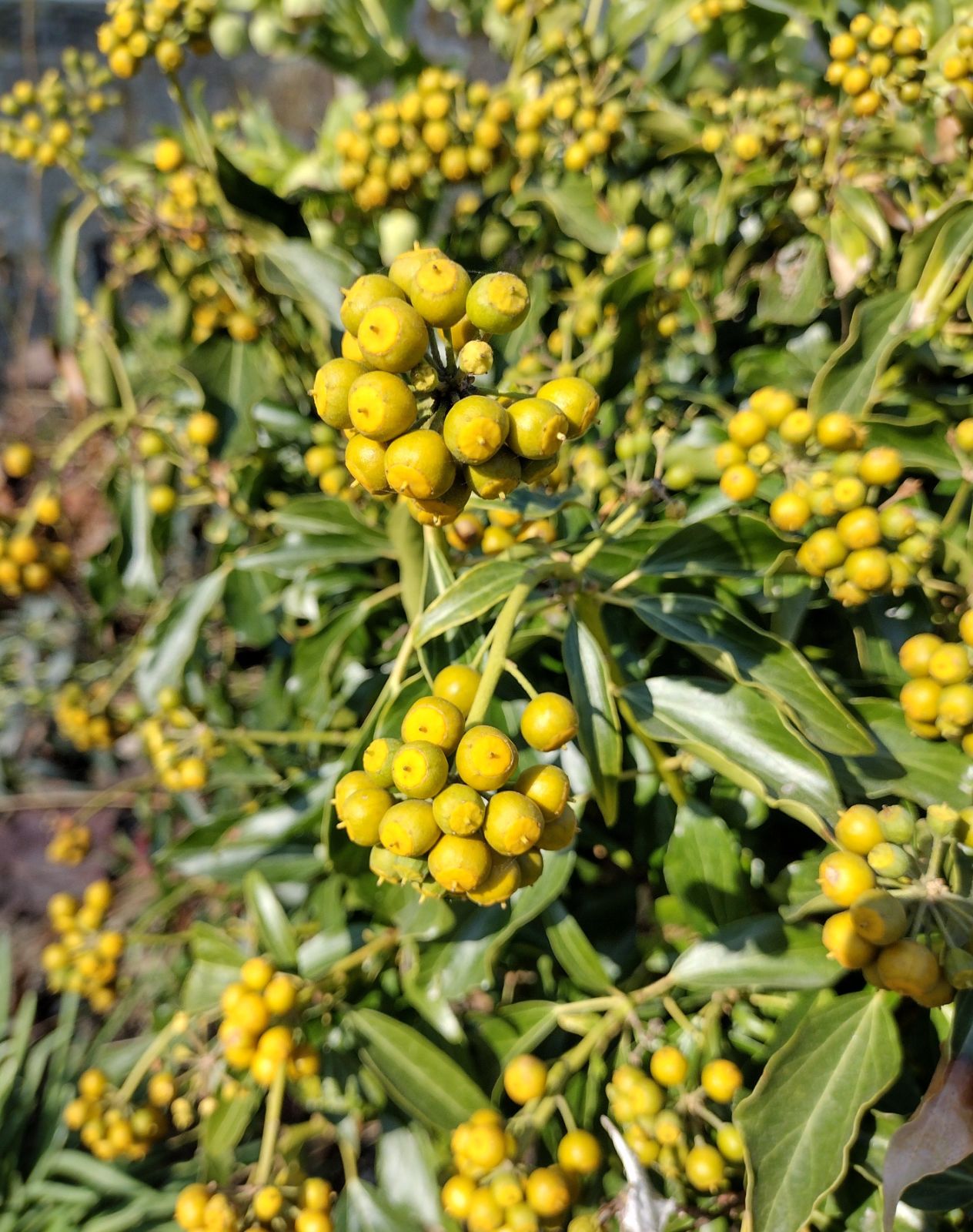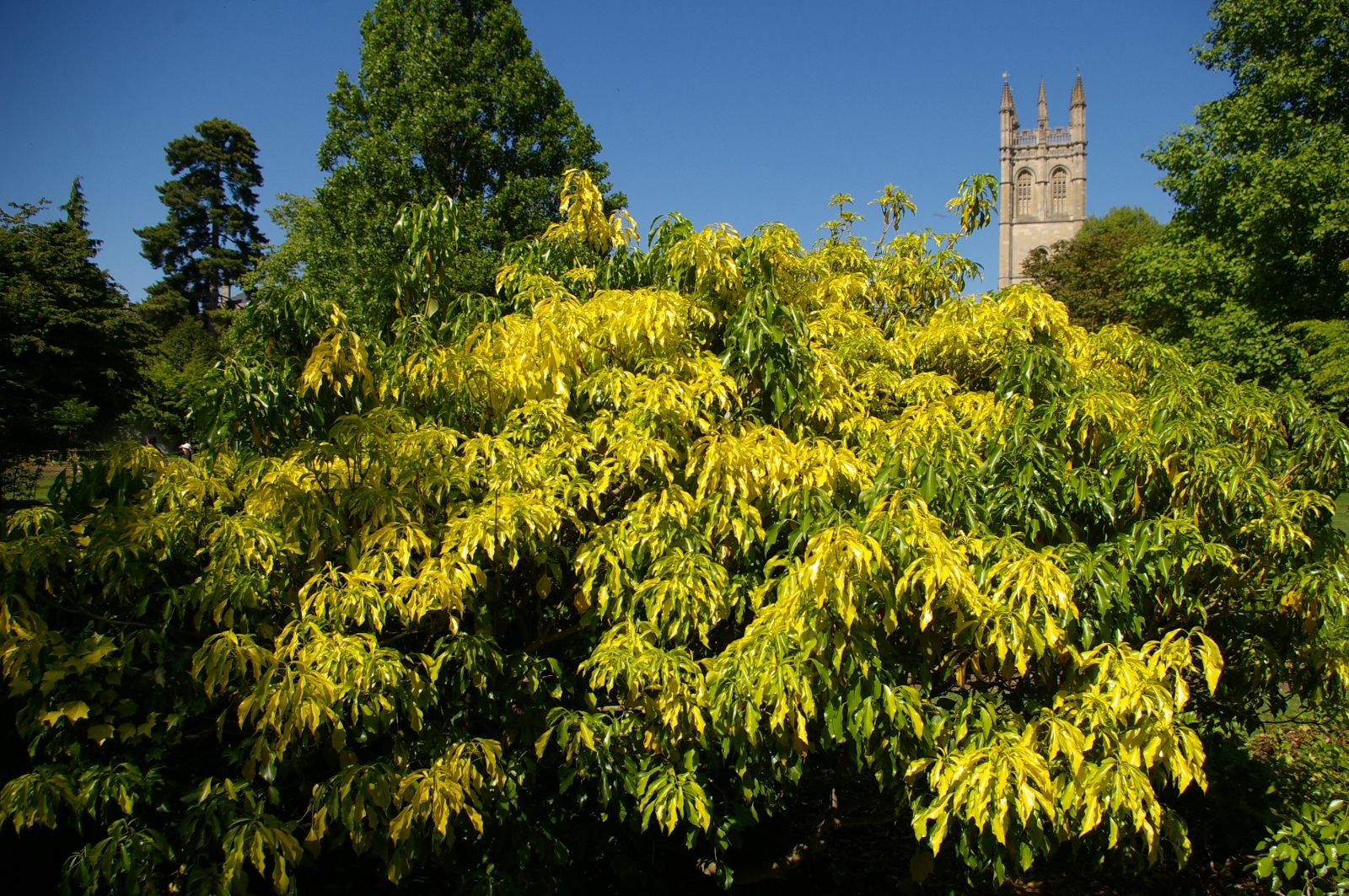Hedera helix
Credits
Article from Bean's Trees and Shrubs Hardy in the British Isles
Recommended citation
'Hedera helix' from the website Trees and Shrubs Online (treesandshrubsonline.
Genus
Common Names
- Common Ivy
Infraspecifics
- 'Adam'
- 'Atropurpurea'
- 'Buttercup'
- 'Cavendishii'
- 'Conglomerata'
- 'Conglomerata Erecta'
- 'Deltoidea'
- 'Digitata'
- 'Donerailensis'
- f. poetarum
- 'Glacier'
- 'Glymii'
- 'Goldheart'
- 'Gracilis'
- 'Green Ripple'
- 'Helford River'
- 'Hibernica'
- 'Hibernica Aurea'
- 'Hibernica Maculata'
- 'Lobata Major'
- 'Marginata Elegantissima'
- 'Marginata Robusta'
- 'Marmorata Minor'
- 'Minima'
- 'Ovata'
- 'Palmata'
- 'Pedata'
- 'Russell Gold'
- 'Sagittifolia'
- 'Sheen Silver'
- 'Spectabilis Aurea'
- var. taurica
An evergreen climber, with a strong, rather acrid odour when crushed, attaching itself to trees, buildings, etc., by means of rootlike growths from the stem, or, where such support is absent, creeping over the ground; young shoots clothed with minute stellate hairs. Leaves alternate, thick, leathery, very dark glossy green, broadly ovate or somewhat triangular, those of the climbing shoots with three or five deep or shallow lobes and stalks of varying length. The starry hairs have five to eight rays. The ivy never flowers on the creeping or climbing shoots, but produces bushy branches, mostly when it has reached the top of its support; these have no aerial roots, and their leaves are never lobed, but are wavy in outline or entire at the margin, and more narrowly ovate. Flowers produced in October, in a terminal cluster of globose umbels, yellowish green. Berries dull inky black, globose, about 1⁄4 in. across, containing two to five seeds.
Native of Europe north as far as southern Scandinavia and east to western Russia, but in the south extending farther to the east through the rainier parts of Anatolia to the Caucasus. It is found almost everywhere in Britain, especially in shady spots, its natural habitat being the forest, where it can climb trees. The ivy, however, is very adaptable, and can be grown in almost any situation. No introduced evergreen climber can rival it for covering old trees, buildings, etc. Many think that serious damage is done to trees by allowing ivy to climb over them, but this only occurs when the ivy has reached the leafy shoots; so long as the ivy is confined to the trunk and larger branches no harm is done. An ivy-laden tree is one of the most beautiful objects of the winter landscape. On houses ivy is rather beneficial than otherwise, keeping them dry and warm.
Ivy is propagated with the greatest ease by means of cuttings which may be given gentle heat if it is desirable to get them to root quickly, or dibbled thickly under handlights or even in the open air. The more delicate highly coloured varieties are sometimes grafted on the common ivy, but need constant watching to prevent the stock over-running the scion. One of the most useful purposes to which ivy can be put is as a ground-covering under trees where no grass will grow. It is also very useful for covering iron-rail fencing, or posts and chains. As regards its use on buildings it is capable of attaining at least 100 ft in height. Leaves of ivy are eaten by horses, cattle, and sheep apparently with relish and without evil results.
There is no work that deals comprehensively with the garden varieties of the common ivy. Hibberd’s book The Ivy (1872), with its elegant descriptions and numerous illustrations, is still of some value as a source of information about the older sorts. Unfortunately, Hibberd took it upon himself to rename many of the garden varieties, on the grounds that the nomenclature, especially of the variegated kinds, was confused, or simply because he disliked the established name. In some cases the name he attempted to abolish is known and can be revived, but often this is not possible. There is no doubt that he could have ascertained the correct name for many of the variegated ivies treated in his work, had he troubled to make the attempt. Nowhere in his book is there any reference to William Paul, one of the greatest plantsmen of his generation, who had a large collection of ivies and indeed may have raised some of the varieties treated by Hibberd.
The garden varieties described below are only a selection of those now available, and are in the main confined to those sold as suitable for growing out-of-doors:
From the Supplement (Vol. V)
Most modern ivies suitable for pot culture are ‘self-branching’, that is to say the lateral buds grow out at once to form side shoots instead of remaining dormant until their second year, as is the case with normal ‘vining’ ivies unless regularly stopped. Such ivies are slow-growing and never cover much ground when planted in the open, but are useful in certain situations.
The cultivars added below are mostly those more familiar as pot-plants, but received awards after the recent open-ground trials at Wisley. The following described in the main work received Awards of Merit in these trials: ‘Atropurpurea’, ‘Conglomerata’, ‘Glacier’, ‘Green Ripple’, ‘Hibernica’ (Irish ivy), ‘Little Diamond’. Some glaring omissions from the lists of awards, notably ‘Buttercup’ and ‘Gold-heart’, arise from the fact that these and some other coloured-leaved cultivars do not succeed except when grown on walls.
For some purple-leaved cultivars of the common ivy see the article by Peter Rose in The Plantsman, Vol. 1(3), pp. 129–32 (1979).
In Flora of Cyprus, Vol.1, p. 769 (1977), Desmond Meikle remarks that the common ivy as seen on the island has less lobed leaves than in Europe. This may also be the case elsewhere in the eastern Mediterranean, judging by plants grown from a cutting collected in eastern Crete, in which the leaves are predominantly quite unlobed and cordate at the base, or at most obscurely and bluntly lobed.
† cv. ‘Chrysophylla’. – The H. helix chrysophylla of Hibberd was intended by him as a collective name for a number of ivies, all very alike when grown together in his garden but received under seven different trade names. ‘The leaves are broad, variously lobed, but the lobes are always obtuse and few in number… . The variegation appears in patches on the young growth, many of the leaves being wholly of a deep yellow, others mottled with paler yellow on a green ground, a large proportion of the plant being of a dark green, without any trace of variegation.’ He added that it is inclined to ‘run out’ (revert) on rich soils.
cv. ‘Conglomerata Erecta’. – Peter Rose points out that there are three erect-branched, non-climbing clones. One is ‘Congesta’, the smallest and best of the three, with leaves 11⁄8 to 15⁄8 in. long, their lobes acute at the apex; it is this which was once in the trade as H. helix minima. The second he suggests should be called ‘Erecta’ simply; it is coarser and more vigorous, with larger, bluntly lobed leaves. The third is ‘Russelliana’, sent out by Messrs Russell early this century; it was lost by them during the second world war, but rediscovered recently in a Surrey garden, and is intermediate in size between the first two. All three probably derive from branch-sports of ‘Conglomerata’.
It should be added that the drawing on page 356 of the main work is of ‘Congesta’, and not of ‘Conglomerata’ as stated in the caption.
cv. ‘Goldheart’. – This well-known clone was raised in Italy and originally listed there as ‘Oro di Bogliasco’. ‘Goldheart’ is now the established name.
cv. ‘Gracilis’. – This name has been usurped by other clones, but the true ‘Gracilis’ is probably still in commerce (Peter Rose, op. cit., p. 108).
cv. ‘Hibernica’. – It has been alleged that this is a semi-adult clone of a species distinct from H. helix, ranging from south-west Scotland and Ireland to Portugal. See the article by H. McAllister cited under H. canariensis, p. 107; also the note by Alison Rutherford and Stephen S. Taffler in Int. Dendr. Soc. Year Book 1975, pp. 59–61.
cv. ‘Hibernica Aurea’. – Peter Rose considers that the correct name for this clone is ‘Hibernica Variegata’.
† cv. ‘Ivalace’. – Leaves dark green and glossy, with undulate margins, which are folded upwards at the sinuses and ‘lacy’ in general effect. Raised in the USA. Reasonably hardy and a good plant for low north-facing walls. ‘Manda’s Crested’ is of the same type but perhaps less hardy. Both received a First Class Certificate in the Wisley trials.
† cv. ‘Luzii’. – Leaves obscurely five-lobed, grey green with yellow-green mottling.
cv. ‘Marginata Elegantissima’. – Peter Rose considers that ‘Tricolor’ is different from ‘Marginata Elegantissima’, having a creamy rather than silvery edge, and that the former is the name that should be used for the cultivated plants.
cv. ‘Marmorata Minor’. – This is also known as ‘Minor Marmorata’.
cv. ‘Ovata’. – This is scarcely the same clone as ‘Deltoidea’, as has been suggested. Mr Bean kept the two separate in earlier editions of this work.
cv. ‘Pedata’. – For this, see further the note by Peter Rose in The Plantsman, Vol. 5 (1), pp. 59–60 (1983).
† ‘Parsley Crested’. – Leaves almost unlobed, ovate to roundish, undulate and crimped at the edge, bright green, with lighter veins. Self-branching. It makes a useful ground-cover for small areas. A.M.T. 1980.
† ‘Pin Oak’. – Leaves light green, to about 1 in. long, three-lobed, the central lobe much longer than the laterals, base cuneate. A self-branching ivy, which forms dense mounds when grown in the open. A.M.T. 1980.
† ‘Pittsburgh’. – Best known as a pot-plant, this ivy received the Highly Commended award in the Wisley trials for its performance in the open ground. It is of historical interest as the first of the self-branching ivies, also known as the Ramosa group. There is nothing particularly distinctive about the foliage.
var. poetica – The Poet’s Ivy perhaps deserves a higher rank than variety. Its distribution as a genuinely wild plant is by no means certain, partly owing to the reluctance of botanists to distinguish herbarium specimens from those of the common ivy, in the absence of fruits. It makes an attractive, neat, free-fruiting, evergreen shrub in its ‘tree’ form. For a note on this ivy by Peter Rose, see The Garden (Journ. R.H.S.), Vol. 110, pp. 26–7 (1985).
cv. ‘Sagittifolia’. – It was remarked that the plant now in commerce under this name is not the same as the H. helix sagittaefolia. It is in fact very similar to ‘Koniger’s Auslese’. There is also a silvery-margined form of the falsely named ‘Sagittifolia’, for which ‘Sagittifolia Variegata’ is the established name. This is self-branching and one of the best variegated ivies for walls (P. Rose, op. cit., fig. 60).
† cv. ‘Sulphurea’. – See Journ. R.H.S., Vol. 100, p. 87 and fig. 25 (1975).
'Adam'
Leaves small, shallowly three-lobed or three-angled, with a regular margin of white; centre grey and grey-green. It is self-branching, i.e., the main stems produce side-branches without the need for stopping. A charming ivy, usually seen as a pot-plant, but said to be hardy. The leaves become much larger on open-ground plants.'Atropurpurea'
Leaves with a long central lobe and two short laterals, but many almost entire and ovate, blackish green, darkening still further in winter and often then becoming bronze-coloured, with bright green veins (Journ. R.H.S., Vol. 12 (1890), p. 390; Garden, Vol. 25 (1884), p. 141). A very handsome ivy at Kew, received under the name H. helix purpurea, probably belongs to this variety.'Buttercup'
Leaves with prominent veins, bluntly three- or five- lobed, deeply cordate, golden throughout the summer. It is sometimes sold as “Angularis Aurea”, a name which belongs properly to an older form of golden ivy, with scarcely lobed leaves.'Cavendishii'
Leaves mostly 1 to 1{1/2} in. long, rather indistinctly lobed, with a broad margin of creamy white, slightly flushed with pink at the edge during autumn and winter. In cultivation by 1863. It is part of the H. helix marginata minor of Hibberd.'Conglomerata'
A dwarfed, very slow-growing form, the leaves small and crowded, much crinkled and undulate. Stems stout, procumbent, slightly flattened when young.'Conglomerata Erecta'
Like the preceding, this is a non-climbing ivy, but with erect or spreading stems, much flattened at first, with the young bract-like leaves arranged in two rows on the sharp edges. Mature leaves variously lobed, often folded upwards along the midrib. It is also known as H. helix minima but unfortunately Hibberd used that name in 1872 for the ivy ‘Donerailensis’, thus rendering it invalid.'Deltoidea'
Leaves very distinct in shape, triangular in main outline, with rounded corners and two deep basal lobes, the inner edges of which overlap. Of stiff habit assuming a bronzy tint in autumn.'Digitata'
The ivy distributed by Loddiges’s nursery early in the 19th century as H. helix digitata is probably the same as the so-called sharp- leaved Irish ivy, which the Irish nurseryman Thomas Hodgins found growing wild near his nursery at Dunganstown, then in Co. Wicklow, and put into commerce around 1825 or earlier. Leaves with five sharp, forward-pointing lobes, separated by narrow sinuses. This ivy has hairs with more numerous rays than is normal in H. helix, and was on that account considered by Seemann to belong to H. canariensis (Journ. of Bot., Vol. 3, (1865), pp. 201–3).cv. ‘Discolor’. Sec ‘Marmorata Minor’.'Donerailensis'
Leaves small, usually three-lobed, the central lobe narrowly triangular, the lateral lobes usually similar in shape to the central one, margins wavy. The leaves turn brownish purple in winter. This clone only retains its character if grown as a pot-plant, with its roots constricted. Allowed to grow freely on a wall the leaves eventually become much larger and very like those of ‘Pedata’ (q.v.). The origin of this clone is not known but it was in cultivation in 1854 and may have originated at Doneraile, Co. Cork. Hibberd in The Ivy (1872) p. 76, renamed this ivy H. helix minima, in accordance with his usual practice of rejecting all epithets derived from placenames or personal names.cv. ‘Emerald Gem’. See under var. poetica.f. poetarum (Nyman) McAll. & A. Rutherf.
Common Names
Poet's Ivy
Synonyms
H. poetarum Bertol.
H. chrysocarpa Walsh
H. helix var. chrysocarpa Ten.
H. helix subsp. poetarum Nyman
H. helix var. poetica Weston
Juvenile leaves brighter green than in the common ivy, triangular or broadly ovate with a heart-shaped base, shallowly lobed and sometimes more or less entire. Fruits yellow, slightly larger than in the common ivy. Native of the S. Balkans, Asia Minor, and W. Caucasus; naturalised in parts of Italy, probably since Roman times. The garden variety ‘Emerald Gem’ probably belongs here.
It is usually cultivated as a free-standing ‘tree ivy’, to which the name ‘Arborea Poetica’ is sometimes applied.
'Glacier'
Leaves shallowly and bluntly three-lobed, mostly truncate to shallowly cordate at the base, edged with a narrow discontinuous margin of white; centre of leaf green and grey-green.'Glymii'
Hibberd altered the name of this ivy to H. helix tortuosa and describes it as follows: ‘The growth is scarcely robust, and rather wiry; the leaves vary in form from regular ovate to long wedge-shaped, many of them obscurely three-lobed. The colour is a deep dull green, overspread with blotches of blackish bronze. The form and colour of the leaves are characteristic features, but they are moreover peculiarly glossy, and every one is more or less curled and twisted, the twisting increasing during cold weather.’'Goldheart'
Leaves dark green, glossy, with an irregular, more or less central blotch of rich yellow; stems red when young. A very striking ivy, much more handsome when grown out-of-doors than as a pot-plant. It is also known as ‘Golden Jubilee’ and, wrongly, as ‘Jubilee’ (according to Tobler the latter name belongs to an ivy with white-edged leaves put into commercc by Messrs Hesse in 1912). A ‘tree-ivy’ with similar variegation has been raised from its adult shoots.'Gracilis'
Hibberd’s description reads: ‘A light elegant plant with wiry stems of a warm purple colour, and leaves usually three-lobed, placed rather far apart, rendering the wiry stems conspicuous; the colour rather light dull green, richly bronzed in the autumn; the principal veins rise slightly in relief. The veins curl slightly, and are seldom sharply lobed. A very pretty wall-ivy or to clothe a tree-stump.’ (The Ivy, p. 67, figured on p. 66.)'Green Ripple'
The plant in commerce as a pot-plant under this name has the following characters: leaves dark mat-green, slenderly stalked, central lobe very slenderly tapered, the main lateral pair similar, forward pointing, basal lobes, when present, shorter and usually blunter; base of leaf usually rounded or cuneate. It is a very elegant ivy, said to be hardy.'Helford River'
A large-leaved ivy found growing wild near the Helford Estuary by George Nicholson, Curator of Kew, in 1890, and introduced by him to the collection, where it still grows. The leaves are conspicuously white-veined, variable in shape but mostly with a long central lobe and two backward-spreading laterals.'Hibernica'
Common Names
Irish Ivy
A tetraploid variant of the common ivy with dull green leaves 3 to 6 in. across, with usually five triangular lobes, the terminal one the largest (H. hibernica Hort. ex DC.; H. helix hibernica Hort. ex Kirchn.; H. canariensis Hort., in part, not Willd.; H. grandifolia Hibberd, in part). See also H. canariensis.The Irish ivy is believed to descend from a plant that was found growing wild in Ireland, but it is not a native of that country in the sense of occurring wild there in significant numbers. It was already well established in cultivation by 1838, and was probably introduced some thirty years before that. It is a strong-growing ivy, useful for ground-cover beneath trees, etc.
'Hibernica Aurea'
Young leaves variegated with gold, some half or three-quarters golden, becoming paler by midsummer (or wholly green on vigorous plants). Paul called this ivy H. canariensis foliis aureis.'Hibernica Maculata'
Leaves blotched and streaked with creamy white (H. canariensis latifolia maculata Paul).'Lobata Major'
Very much resembling the Irish ivy but with a longer central lobe, separated from the two lateral lobes by narrower and sharper sinuses. Hibberd remarks: ‘In the woods of the Vale of Conway, North Wales, this form may be frequently met with’, but the cultivated plants are probably all of one clone.'Marginata Elegantissima'
Leaves small, scarcely lobed, more or less truncate at the base, with a broad margin of silver. The specimen in the Kew Herbarium is from William Paul. There is an ivy still in commerce as ‘Elegantissima’ or ‘Tricolor’ which agrees with this and has leaves which become margined with pink in the autumn (Paul remarked that several silver ivies show this coloration in autumn, adding that it ‘is hardly prominent enough… to be admitted in the descriptions from the pictorial point of view’ – Gard. Chron. (1867), p. 1270).cv. ‘Marginata Major’. See under ‘Marginata Robusta’.'Marginata Robusta'
Leaves large, some of almost adult form, bluish green, with a broad margin of white (Paul, Gard. Chron. (1867), p. 1215; Hibberd, op. cit., p. 78, as H. h. marginata grandis). Plants agreeing with this are still in cultivation. ‘Marginata Major’ is similar, but the margins are yellowish white.'Marmorata Minor'
Leaves speckled and blotched with white, some mainly white, with green markings (H. h. discolor Hibberd).'Minima'
An ambiguous and confusing name. The H. h. minima of Hibberd is ‘Donerailensis’. The same name is also used for ‘Conglomerata Erecta’.'Ovata'
A very distinct ivy, the leaves ovate, pointed rounded at the base, rich green and entire, or very slightly lobed even in the climbing state.'Palmata'
Leaves strongly five-lobed, mostly truncate at the base; veins prominent beneath (Hibberd, op. cit., p. 77).'Pedata'
Common Names
Bird's Foot Ivy
Leaves dark green, white-veined, the central lobe disproportionately long, narrowed at the base, often slightly lobulate; lateral lobes spreading; basal lobes, when present, backward pointing. This ivy appears to have been sold by William Paul as H. helix digitata, and it is under this erroneous name that Nicholson figured it in Diet. Gard., Vol. 2 (1886), p. 121. ‘Caenwoodiana’ is very similar and is perhaps part of ‘Pedata’ as understood by Hibberd.
'Russell Gold'
Leaves greenish gold when young.'Sagittifolia'
Central lobe acute, triangular (i.e., broadest at the base and not narrowed at the base as in ‘Pedata’); lateral lobes spreading more or less horizontally, basal lobes swept backward (Hibberd, op. cit., pp. 68–9). The very common house-plant grown at the present time under this name is not the same clone as Hibberd’s plant. The general shape of the leaf is the same, but the lobes are more taper-pointed.'Sheen Silver'
Leaves slightly lobed, broadly margined with white; centre blue-green and grey-green.'Spectabilis Aurea'
var. taurica (Tobler) Rehd.
Synonyms
H. poetica (?) var. taurica Tobler
H. taurica sensu Poyark

